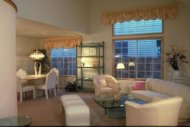L Shaped Living room
 If there are no interior walls it is one room.
If there are no interior walls it is one room.
The design guideline governing window treatments is that all windows in any room should be treated the same. A room is one space within four walls. As with most guidelines, this one may be bent to accommodate your needs and preferences — and to showcase your individualism — but a well-designed room will adhere to the basic tenet. A savvy homeowner can use designers' tricks to make the window treatments in an L-shaped living room and dining room appear to match and keep the space unified in style, yet separate in function.
Keep all the window treatments within the design style of the room. For example, in a contemporary room you may use pinch-pleats in the living room and a box-pleated valance and side panels over pleated shades in the dining room. A similar scheme in a traditional room could consist of pinch pleats in the living room with a swag valance and a swag valance alone in the dining room.
Choose a fabric that fits the mood, style and color scheme of the room and use it on all the windows. It may be used alone or in conjunction with one blind or shade fabric.
Use the same base hardware on all window treatments: the same wood stain, or the same metal. Typically only one metal is used throughout a room. For example, if the lamp bases are pewter, use this metal for all the window treatments. If all the wood in the room is dark cherry, the window hardware should also be dark cherry.
Use one theme element for the hardware. For example, a rectangular medallion hold-back would suit the floor-to-ceiling pinch pleats in a contemporary living room and be complemented by a rectangular finial on the pole-mounted stationary panels in the dining room. A more ornate finial would be suitable for a traditional room.
Mount all window treatments, if possible, at the same height around the room. Coupled with consistent fabric and hardware, this will help create balance between the two areas.
Install the same lining in all the window treatments to prevent perceived color changes. Drapes or blinds with blackout lining may look different than valances or side panels with regular lining.
Incorporate the same trim or embellishment color and style on all coverings. For example, in the living room a tassel tieback could be paired with matching tassel fringe on the valance in the dining room.
Tip
- Using something three times in a room makes it an important part of the design plan. For example, use the same wood color on the floor, the chair legs and the curtain rods. Using the same fabric on two windows and a chair cushion increases the perceived importance of each element while uniting the scheme.
Related posts:

 Mirrors act as magicians in your home: They make spaces appear larger, multiply light, and duplicate views. Depending on their size and placement, they can play…
Mirrors act as magicians in your home: They make spaces appear larger, multiply light, and duplicate views. Depending on their size and placement, they can play… How to arrange the living room furniture is up to you and your particular pieces. Most of us have a sofa and another chair or two, which we can position and reposition…
How to arrange the living room furniture is up to you and your particular pieces. Most of us have a sofa and another chair or two, which we can position and reposition… This cozied-up formal dining room is wonderful for those who have a large family or group of friends and often find themselves throwing dinner parties or hosting…
This cozied-up formal dining room is wonderful for those who have a large family or group of friends and often find themselves throwing dinner parties or hosting… Will it work in the space I have planned? Our published dimensions (e.g. 93 Wx46 Dx32 H) width x depth x height in inches, will help you decide if your furniture…
Will it work in the space I have planned? Our published dimensions (e.g. 93 Wx46 Dx32 H) width x depth x height in inches, will help you decide if your furniture… Schlafzimmer: Ideen, von der Einrichtung bis zur Deko Überlegen Sie sich vor dem Einrichten die Anordnung Ihrer Schlafzimmermöbel. Ist der perfekte Standort für…
Schlafzimmer: Ideen, von der Einrichtung bis zur Deko Überlegen Sie sich vor dem Einrichten die Anordnung Ihrer Schlafzimmermöbel. Ist der perfekte Standort für…